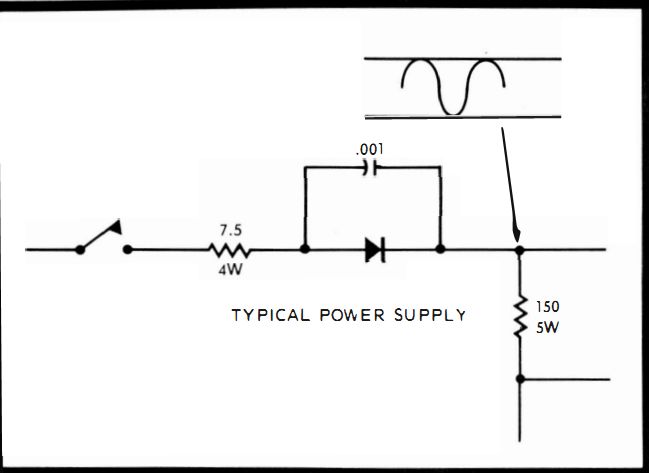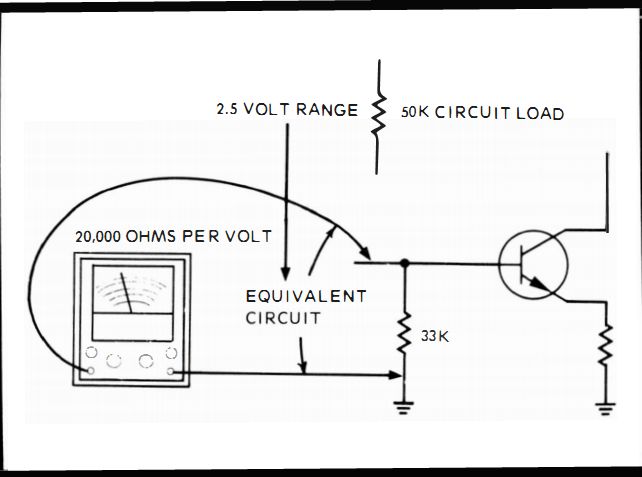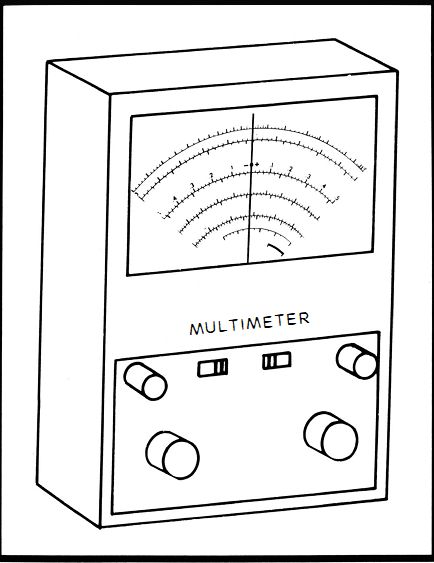AMAZON multi-meters discounts AMAZON oscilloscope discounts
No. 127: CHECKing RIPPLE IN POWER SUPPLY
A power supply that changes AC to DC is changing a sine-wave input to a DC voltage. Most ordinary power supplies do a satisfactory job, but cannot get all of the AC out of the DC. The remaining AC is called "ripple " (Fig. 85 ). It is useful to check ripple voltage. Hum in radios or weaving in TV pictures can be caused by excessive ripple. Too much ripple indicates defective filter capacitors.
Ripple can be checked with a scope or the p-p scale of a multimeter if it is sensitive enough. When the scope is used and the peak-to-peak ripple is compared to the 117-volt amplitude, it's a rough check, unless you actually measure the ripple with a ruler. Of course, the scope can be calibrator for p-p readings. The multitester indicates the ripple voltage directly on the meter scale.
No. 128: ACCURATE VOLTAGE TESTS
During troubleshooting it is necessary to take voltage readings. For practical purposes it is not mandatory that readings be right on the nose. In most cases , an accuracy between 10 and 20 percent is permissible. Any more than 20 percent can throw the servicer off his path. As a result , the choice of a voltmeter is important. VOMs are the handiest since they are portable and can be used anywhere without the need for 117-volt electric power. VOMs, though, should be used judiciously, since they load down a circuit and introduce large errors. Suppose you are going to test a transistor amplifier. The first place a test can be made is at the base to see if the transistor is correctly biased. If a conventional 20,000 ohms per volt meter is used, the bias would be more than 20 percent off and provide a false trouble clue. The VOM loads the circuit, and, when it is attached , acts just as if you connected a 50,000 ohm resistor across the 33 ,000-ohm base-to-ground resistor (Fig. 86 ).

Fig. 85. Ripple voltage is usually too low to cause trouble, but it's useful
to have the capability to test it.

Fig. 86. Using a 20,000 ohms-per-volt VOM in the 2.5-volt range is like putting
50 K across the circuit.

Fig. 87. Most multimeters have a zero-center scale. In some cases, it's very
useful.
Figuring it roughly , the 50K across the 33K changes the effective base resistor to 20K. The bias voltage drops, the transistor loses its forward bias and cuts off. All the voltages in the circuit are then incorrect. To make accurate voltage readings a voltmeter with a high impedance-in the meg-ohms-has to be used. Then the 33K stays near its 33K effective value.
No. 129: ZERO CENTER RANGE TEST
There are many different tests where the zero center range of voltmeter is mandatory and there are others where it is faster to use a zero center than conventional polarity switching.
Discriminators, ratio detectors in FM and TV sets , automatic fine tuning-in fact, any dual-diode phase detector calls for a zero center scale. In solid-state circuits the voltages are relatively small and range both ways from center. The zero center is faster than switching the emitter polarity from plus to minus. Manufacturers specify in TV and FM alignment notes that certain adjustments must be made with zero center. Whatever the test, the zero center is set up like this : The appropriate plus DC scale is selected, the zero adjust knob is turned until the meter needle arrives at the correct setting. There is usually a zero setting at midscale (Fig. 87). Then the circuit is explored. A reading to the right of zero is a positive reading. A reading to the left is negative. For instance, suppose you ha ve a color TV with a color sync phase detector that is supposed to have minus 35 volts on the top diode and plus 35 volts on the bottom diode. You touch the meter probe to the top diode and the needle goes to minus 35 volts downscale. Then you touch the bottom diode and the needle goes to plus 35 volts upscale. That is correct, too. That's a lot easier than switching the scale polarity from plus to minus.